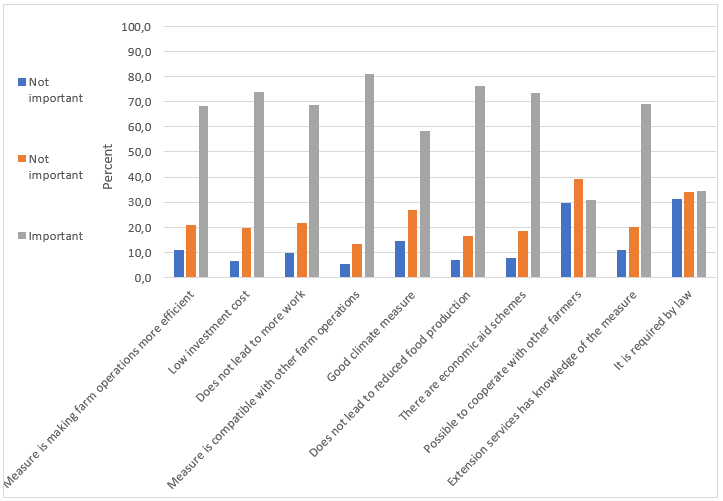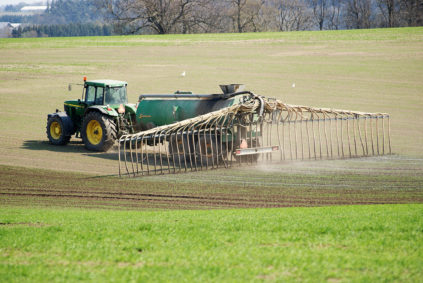Nine out of ten Norwegian farmers have implemented or plan to implement measures that reduce greenhouse gas emissions on their farm. But whether the measure is good for the climate is considered unimportant.
It is more likely that younger farmers will implement climate measures than older farmers. Other factors that come into play are farm size, income and education. It emerges from the Ruralis report «Opportunities and barriers for the introduction of climate measures on Norwegian farms».
The report presents results from the survey «Trends in Norwegian agriculture 2020». Here, farmers are asked about the implementation of a selection of measures that are considered good for the climate. The analyzes show that there are some differences between different farmers and different farms in which measures they choose to implement, and why they choose to implement the measures.

* The figure shows the proportion of farmers who have implemented, or planned to implement, various measures.
Provides more accurate measures
– This knowledge is necessary to facilitate that agriculture’s greenhouse gas emissions can be reduced sufficiently, and it can make advisers and authorities better able to give climate advice to a diversity of farmers. The work to reduce emissions depends on accurate measures, and agriculture is no exception, says researcher Anders Mahlum Melås in Ruralis.
In the age group under 40 years, 96 per cent of the respondents have implemented or planned to implement one or more climate measures. In the group over the age of 60, the proportion drops to 82.5 per cent.
Table 1. Age and implementation of one or more measures
| Under 40 years | 40-59 years | Over 60 years | |
| Not feasible/ not applicable | 4,1 % | 9,6 % | 17,5 % |
| Completed or plannet | 95,9 % | 90,4 % | 82,5 % |
Farmers are self-employed who have to deal with the economic bottom line, other farming operations, work pressure and long-term development. Farmers with smaller farms are less likely to implement measures than farmers on larger farms. It is also less likely that farmers with lower incomes from the farm will implement measures.
Economy more important than climate
– For eight out of ten, it is important that the climate measure can be combined with the rest of the farm, that it does not lead to reduced food production and that there are financial support schemes for the measure. What is considered the least important is that it is possible to cooperate with other farmers on the measure, and that it is a good climate measure, says Mahlum Melås.
Barely 60 per cent of the farmers thought it was important that the measure they implemented was a good climate measure. This indicates that whether the measure is perceived as good or less good for the climate is not emphasized very strongly. Therefore, the authorities may benefit more from marketing other aspects than reducing emissions to farmers.

* The figure shows how important or unimportant the farmers think the various factors are for them to implement climate measures on their farm.
Different education, different priorities
Farmers with higher education believe to a greater extent than farmers without higher education that it is important that the measures can be combined with other operations, that there is a good climate measure and that there are advisers who have knowledge of the measure.
– An interesting finding is the differences between farmers with higher education and farmers with agricultural education. It seems that farmers with an agricultural education prioritize the more “low-tech” agronomic measures, while farmers with a higher education look towards more high-tech alternatives, such as biochar and solar cells, says Mahlum Melås.
The size counts
The size of the farm is the property of the farm that affects the most of the measures examined in the study. 15.5 per cent of the farmers with farms where the size is below the national average have not implemented or planned to implement any of the measures (the average size of Norwegian farms in 2019 was 252 decares). The corresponding figure for the farms above the average is 4.5 per cent.
– This does not necessarily mean that farmers with smaller farms are less climate-conscious, or that smaller farms are less climate-friendly. For example, there is no difference between farmers on farms of different sizes in whether they believe that agriculture should prioritize reducing greenhouse gas emissions from agriculture weaker or stronger, Mahlum Melås emphasizes.
Farm size seems to be relatively important for whether measures are implemented or not, and this indicates that there may be some economies of scale in some of the measures. In order to make it easier for smaller farms to follow suit and implement more measures, agriculture and its advisers could possibly look even more for the potential for better facilitation of cooperation between more farmers.
There are also several climate measures other than those examined in this study.
Full report in Norwegian: Muligheter og barrierer for innføring av klimatiltak på norske gårder
